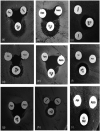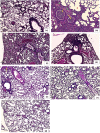A Novel Triple Combination To Combat Serious Infections with Carbapenem-Resistant Acinetobacter baumannii in a Mouse Pneumonia Model
- PMID: 35975993
- PMCID: PMC9603289
- DOI: 10.1128/spectrum.02710-21
A Novel Triple Combination To Combat Serious Infections with Carbapenem-Resistant Acinetobacter baumannii in a Mouse Pneumonia Model
Abstract
The ongoing crisis of antimicrobial resistance demands novel combinations between antimicrobials and nonantimicrobials to manage infections caused by highly resistant pathogens. This study aimed to evaluate the effect of combining sodium ascorbate and/or apo-transferrin with imipenem, forming double and triple combinations, against 20 multiple-carbapenemase-producing Acinetobacter baumannii strains using the checkerboard test, time-kill assay, and disc diffusion test. The results of the checkerboard assay revealed that all double combinations showed indifference, while only triple combination recorded a synergistic effect (fractional inhibitory concentration index [FICI] < 0.8) in 95% the test isolates. Moreover, the MIC of imipenem (MICimp) was strongly reduced (up to 128-fold reduction) after treatment with the triple combination against highly resistant isolates and reached the susceptible range. The time-kill assay revealed that the triple combination led to a 4-log10 reduction in the CFU at 8 h compared with the initial bacterial count, and no viable count was recorded at 10 h. The mouse pneumonia model showed restoration of lung function and structure, with mild to moderate residual inflammation and moderately congested vessels observed 8 h following administration of the triple rescue therapy. Additionally, normal lungs with normal patent alveoli were detected 72 h following treatment. Accordingly, sodium ascorbate and apo-transferrin are promising adjunct biological agents with the potential to restore the effectiveness of critically essential antibiotics like imipenem, commonly used for the treatment of A. baumannii infections. IMPORTANCE Combination therapy provides a perspective to threat multidrug-resistant (MDR) strains. The present study sheds light on a novel and effective triple combination against carbapenem-resistant A. baumannii. Our in vitro results showed that combining imipenem with apo-transferrin and sodium ascorbate yielded synergism in 95% of test isolates, and this was associated with a marked reduction in imipenem MIC, shifting it below the breakpoint. Furthermore, a bactericidal effect was recorded, with no viable count detected at 10 h. An in vivo murine model of pneumonia was induced to mimic human disease. The triple combination therapy restored lung function and structure, with mild to moderate residual inflammation and moderately congested vessels observed 8 h following the initiation of therapy. Therefore, our findings suggest novel insights about a promising new combination therapy against highly resistant carbapenemase-producing A. baumannii to restore the effectiveness of imipenem.
Keywords: A. baumannii; carbapenemases; pneumonia; synergism; triple combination.
Conflict of interest statement
The authors declare no conflict of interest.
Figures






Similar articles
-
[In vitro synergistic activity of sulbactam in combination with imipenem, meropenem and cefoperazone against carbapenem-resistant Acinetobacter baumannii isolates].Mikrobiyol Bul. 2014 Apr;48(2):311-5. doi: 10.5578/mb.7104. Mikrobiyol Bul. 2014. PMID: 24819268 Turkish.
-
In vitro Evaluation of the Colistin-Carbapenem Combination in Clinical Isolates of A. baumannii Using the Checkerboard, Etest, and Time-Kill Curve Techniques.Front Cell Infect Microbiol. 2017 May 24;7:209. doi: 10.3389/fcimb.2017.00209. eCollection 2017. Front Cell Infect Microbiol. 2017. PMID: 28596943 Free PMC article.
-
Novel approach to optimize synergistic carbapenem-aminoglycoside combinations against carbapenem-resistant Acinetobacter baumannii.Antimicrob Agents Chemother. 2015 Apr;59(4):2286-98. doi: 10.1128/AAC.04379-14. Epub 2015 Feb 2. Antimicrob Agents Chemother. 2015. PMID: 25645842 Free PMC article.
-
Cefiderocol: A Siderophore Cephalosporin with Activity Against Carbapenem-Resistant and Multidrug-Resistant Gram-Negative Bacilli.Drugs. 2019 Feb;79(3):271-289. doi: 10.1007/s40265-019-1055-2. Drugs. 2019. PMID: 30712199 Review.
-
Sulopenem: An Intravenous and Oral Penem for the Treatment of Urinary Tract Infections Due to Multidrug-Resistant Bacteria.Drugs. 2022 Apr;82(5):533-557. doi: 10.1007/s40265-022-01688-1. Epub 2022 Mar 16. Drugs. 2022. PMID: 35294769 Review.
Cited by
-
An Update Review of Approaches to Multiple Action-Based Antibacterials.Antibiotics (Basel). 2023 May 6;12(5):865. doi: 10.3390/antibiotics12050865. Antibiotics (Basel). 2023. PMID: 37237768 Free PMC article. Review.
-
A chronic murine model of pulmonary Acinetobacter baumannii infection enabling the investigation of late virulence factors, long-term antibiotic treatments, and polymicrobial infections.bioRxiv [Preprint]. 2024 Sep 18:2024.09.17.613469. doi: 10.1101/2024.09.17.613469. bioRxiv. 2024. Update in: Nat Commun. 2025 Aug 15;16(1):7617. doi: 10.1038/s41467-025-62655-4. PMID: 39345519 Free PMC article. Updated. Preprint.
-
Ascorbate and Antibiotics, at Concentrations Attainable in Urine, Can Inhibit the Growth of Resistant Strains of Escherichia coli Cultured in Synthetic Human Urine.Antibiotics (Basel). 2023 May 31;12(6):985. doi: 10.3390/antibiotics12060985. Antibiotics (Basel). 2023. PMID: 37370304 Free PMC article.
-
Characterization of GQA as a novel β-lactamase inhibitor of CTX-M-15 and KPC-2 enzymes.Microb Cell Fact. 2024 Aug 8;23(1):221. doi: 10.1186/s12934-024-02421-1. Microb Cell Fact. 2024. PMID: 39118086 Free PMC article.
-
Synergy of ATP and Meropenem in Stimulating the TCA Cycle to Enhance Killing of Carbapenem-Resistant Acinetobacter baumannii.Microb Biotechnol. 2025 Jul;18(7):e70199. doi: 10.1111/1751-7915.70199. Microb Biotechnol. 2025. PMID: 40690193 Free PMC article.
References
-
- Stein C, Makarewicz O, Bohnert JA, Pfeifer Y, Kesselmeier M, Hagel S, Pletz MW. 2015. Three-dimensional checkerboard synergy analysis of colistin, meropenem, tigecycline against multidrug-resistant clinical Klebsiella pneumonia [sic] isolates. PLoS One 10:e0126479. doi:10.1371/journal.pone.0126479. - DOI - PMC - PubMed
-
- Vourli S, Tsala M, Kotsakis S, Daikos GL, Tzouvelekis L, Miriagou V, Zerva L, Meletiadis J. 2016. Comparison of short versus prolonged infusion of standard dose of meropenem against carbapenemase producing Klebsiella pneumoniae isolates in different patient groups: a pharmacokinetic-pharmacodynamic approach. J Pharm Sci 105:1513–1518. doi:10.1016/j.xphs.2016.02.008. - DOI - PubMed
-
- Karakonstantis S, Kritsotakis E, Gikas A. 2020. Treatment options for K. pneumoniae, P. aeruginosa and A. baumnanii co-resistant to carbapenems, aminoglycosides, polymexins and tigecycline: an approach based on the mechanisms of resistance to carbapenems. Infection 48:835–851. doi:10.1007/s15010-020-01520-6. - DOI - PMC - PubMed
MeSH terms
Substances
LinkOut - more resources
Full Text Sources
Medical

